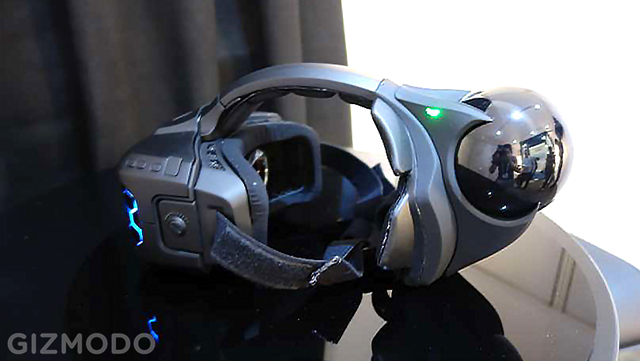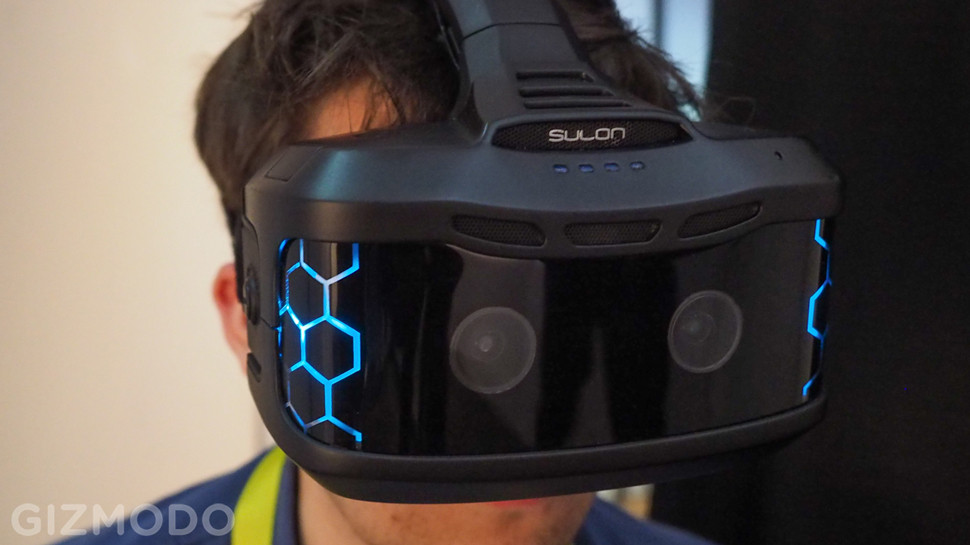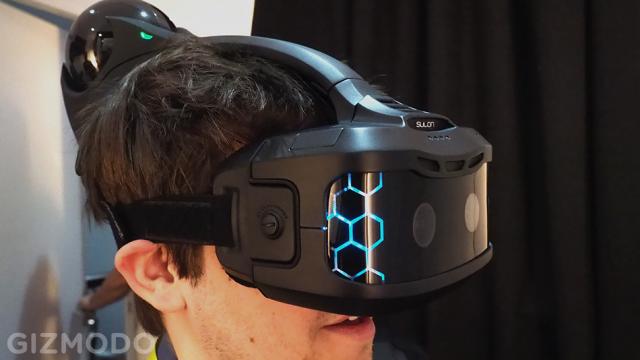VR is coming, for real this time, and everyone wants a piece of the pie. Me, I want to put every dumb-looking headset I see onto my face. Today it was the Sulon Cortex, a big ol’ camera-toting headset that claims it will turn your living room into the holodeck. It can’t quite pull it off, but it tries its damnedest.
The Sulon Cortex is basically part Oculus, part Kinect. It actually doesn’t use either of those gadgets, but the end result is a mix of the two concepts. The self-contained unit (no tethering to a PC!) is a screen mounted in front of your face, and a big, wide-angle ball-shaped IR camera that sits on the back of your skull like an all-seeing boil. By teaming up, the two can map a 3D model of the room in seconds, and then feed it back to you on the screen, with dragons and portals and whatever else added in for extra fun.

I got to play with two demos. The first started with a live feed of the room I was in — but with a mysterious portal lodged in the corner. When I walked over to it in real life and stepped through, I was suddenly standing on a platform surrounded by lava, shooting a dragon with magic from my my hands. In a second, less gamey one, I just walked around a floating engine block, exploring it from all angles.
Both of the demos were neat, and the premise of a VR headset that knows what’s actually around you seems sound, but the whole experience was riddled with problems. Some are fixable, but others are more inherent, and it makes me wonder if this wonderfully insane device has any real future.

First and foremost, the VR aspect of it just wasn’t up to snuff. At all. This is a prototype unit, sure, but the frame rate was low, which really killed the immersion. It felt further behind than the first Oculus Rift, thanks in part to some pretty clunky Half-Life-grade graphics. The hand-tracking — which works by way of a device that looked like a Leap Motion but that Sulon would not confirm is a Leap Motion — was spotty too. Nothing close to what Project Morpheus can achieve with Move controllers.
But those are just bugs. The unit that I tried is an early prototype, pre-developer kit. It still had exposed wires. In fact, the pictures in this post are of a (pretty similar) mockup, because Sulon is apparently too bashful to show off the working model. So with the tech so nascent, these issues could get ironed out. But there are other, more built-in problems too.

Because it’s about walking around and being mobile, the Cortex is a self-contained unit. The games actually run on a chip somewhere in that headset. Sulon wouldn’t tell me what it was exactly, but it ain’t nothing like a good gaming computer, I can guarantee you that. While mobile graphics processors are getting crazy good, this thing’s power will always be limited.
So there’s that. And if you thought wearing a VR headset made you a little queasy, try walking around with one on. It’s especially strange when you’re looking at the real world; just like seeing your surroundings through a Gear VR, the perspective is all off because the cameras and your eyes don’t line up. Looking at the world around you through a screen with a delay is never fun — unless you’re just looking to get dizzy.

Sulon is hoping to ship its first developer units sometime later this year, or early next year at the latest. When that happens, maybe some of the more minor kinks will be ironed out.
But as cool as the concept is, and as badly as I want something — anything — to transform my living room into a fantastical otherworld, I’m sceptical the Cortex could ever pull it off. Maybe the answer is glasses, not goggles. Or maybe it’s beam-it-on-your-eye tech like Magic Leap might be trying. In the meantime, I’ll just keep strapping big dumb things to my big dumb face and hoping.
